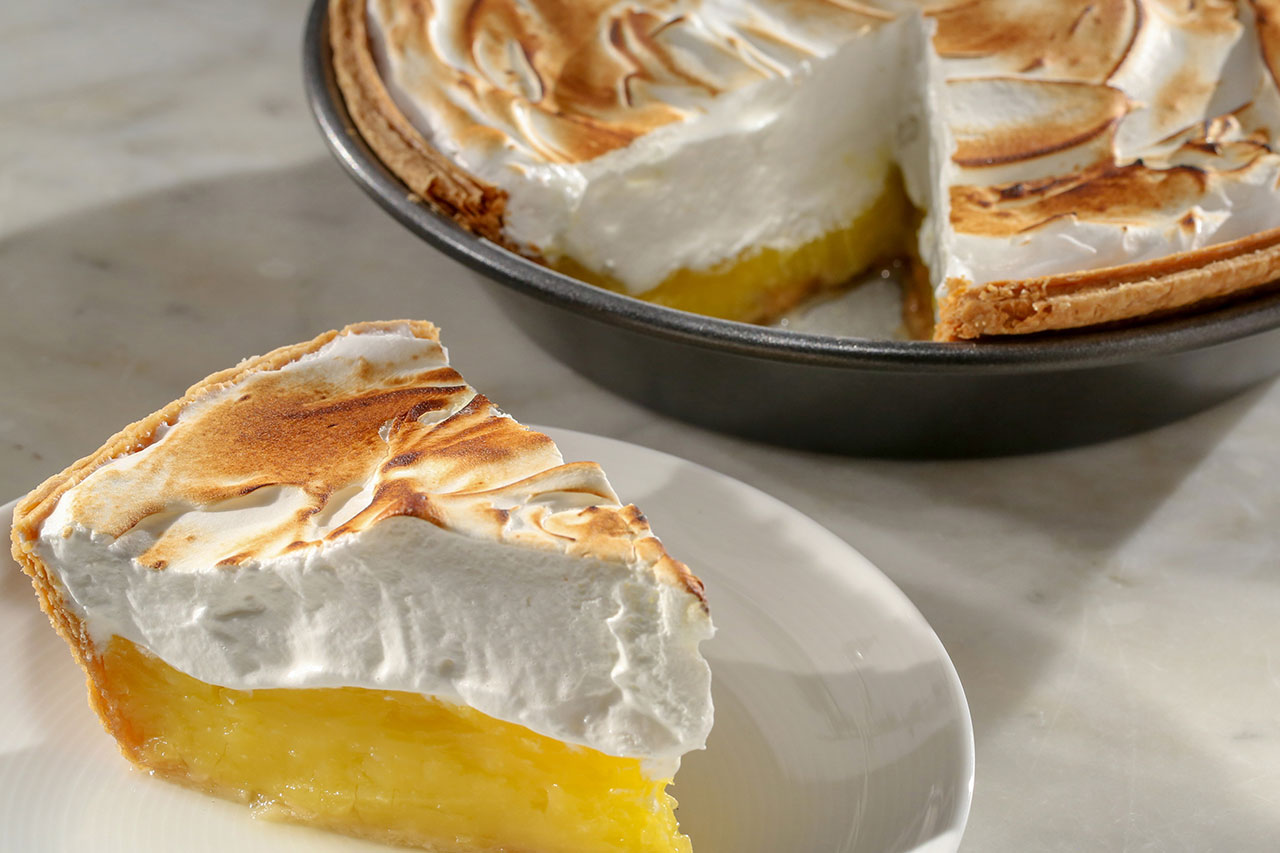
Alton gives his lemon meringue pie recipe a fresh new twist with a new crust, a new filling and a new meringue.
ingredients
Crust
Lemon Filling
Meringue Topping
directions
Hardware:
Food processor
2 metal pie pans
Rolling pin
Cooling rack
Half-sheet baking pan
Stand mixer with whisk attachment
Instant read thermometer
Place butter in the freezer for 15 minutes along with two identical 9-inch metal pie pans.
Combine flour and salt in the bowl of a food processor and pulse 2 to 4 times then add butter and pulse 8 to 10 times, until texture looks mealy and no large lumps of butter remain (see Cook’s Note). Pour in water and pulse 5 times. (At this point the mixture should hold together when squeezed.) Turn dough out onto a sheet of plastic wrap and draw the plastic up around it, squeezing and pressing the dough into a ball. Flatten into an inch thick disk and refrigerate for 30 minutes.
Remove dough from refrigerator, unwrap and place on a lightly floured piece of parchment paper. Dust the top of the disk with a small amount of flour and top with a second sheet of parchment. Roll dough out into a round ⅛-inch thick. If the dough is too firm to roll at first, give it 5 minutes to soften, but not much more or the fat may start to melt.
Remove pie pans from the freezer and invert one. Lay the dough, sandwiched between parchment sheets, over the inverted pan and peel back the top sheet of parchment. Place the second pan over the inverted pan and press down gently to shape the dough. Flip both pans over, lift the top one out, peel away the other piece of parchment, set the pie pan back into the other. Flip the pan/dough sandwich over and trim away excess dough. Freeze the dough sandwiched between the pans for at least 30 minutes.
Meanwhile, position a rack in the center of the oven with a second just beneath it. Heat oven to 300°F.
Place inverted pie pans in oven directly on the top rack and place a sheet on the lower rack to catch any butter that might render out. Bake for 1 hour then crank the oven to 375°F, and bake until browned, about 15 minutes more. Remove from oven and cool for 20 minutes with both pie pans in place. Then invert, remove the top pie pan and cool completely while you make the filling.
Whisk egg yolks until light in color in a medium nonreactive bowl and set aside.
Whisk sugar, cornstarch, water and salt in a medium saucepan and bring to a simmer over medium heat. Whisk in butter and continue whisking until just boiling (mixture will become thick and glossy and almost clear).
Remove from heat and temper the yolks by slowly adding the hot starch mixture to them a whisk full at a time, stirring constantly until one-third of the starch mixture has been worked into the eggs, then return that mixture to the saucepan.
Stir in the lemon juice and zest, reduce heat to medium-low and whisk constantly until mixture returns to a boil. Cook for one full minute more then pour into the pie shell. Cool at room temperature an hour and a half before topping with meringue.
Whisk together egg whites, sugar, cream of tartar and salt in the bowl of a stand mixer then place the bowl over a pot of simmer water to improvise a double boiler. Whisk constantly until mixture reaches 165°F.
Return the bowl to the stand mixer fitted with the whisk attachment and beat on high until soft peaks form, about 1 minute. Reduce speed to medium and continue to beat until stiff peaks form, about 5 minutes more.
Top pie with meringue, making sure to anchor the meringue to the edges of the crust.
Torch to brown if desired, and who doesn’t desire torching a meringue?
Cook’s Note: A food processor “pulse” lasts about a second.
Propane gas torches are highly flammable and should be kept away from heat, open flame and prolonged exposure to sunlight. They should be used only in well-ventilated areas. Follow torch manufacturer’s instructions for use.
